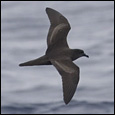
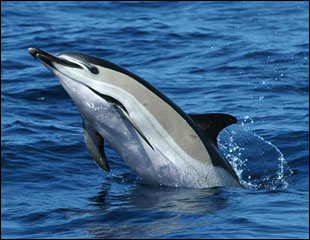 |
| Short-beaked Common Dolphin off Madeira. Photo: Luis Dias, Madeira. |
Today the Madeiran whale boats no longer leave to hunt cetaceans, and the long battles at sea are just stories which the old whalers tell at the doors of the old boathouse. However, the whales have not left the archipelago, and they presently support a fast-growing whale-watching industry that attracts a new generation of eco-friendly whalers. Many places all over the world have already realised that this new activity can produce more money, causes less impact on the animals, attracts thousands of tourists and preserves our natural world heritage. In addition, the fact that cetaceans are no longer hunted ensures that this is a guaranteed long-term industry. Like many other areas worldwide, Madeira has changed its attitude towards cetaceans. Since 1981, after 40 years of whaling, whales and dolphins are now legally protected in Madeiran waters. Fortunately, whales were not hunted to extinction, and today the whale- and dolphin-watching in Madeira can be an incredible experience for all, including adults, children, keen seawatchers, and travellers who are just interested in nature. The observation of these magnificent marine mammals in their natural habitat is a moment that stays forever in the memory.
In Madeira there are several boat companies that provide dolphin-watching tours, however, only "Ventura do Mar" includes a marine biologist as a guide during their daily trips off South Madeira or to the Desertas Islands. This company also provides identification field guides onboard, and operates in a safe and professional manner. The growth of the whale-watching industry has led to the establishment of rules, regulations and codes of conduct governing whale-watching activities. These attempt to manage the growth of the industry and to lessen potential impacts on the whales.
Photos of Cetaceans
in the Madeira archipelago
The Madeiran waters are very rich in cetaceans, with at least 22 species
recorded. These includes species which is listed below. Click the linked
names to view photos of each species in larger size, of which all is photographed
within the Madeira archipelago. The clear majority is photographed by
the marine biologist Luis Dias (Madeira), who also is the main skipper
on the boat "Ventura
do Mar".
Photos added on 16th September 2009: Vincent
van der Spek have kindly provided photos of Bryde's Whale, Spotted Dolphin,
Pilot Whale and Loggerhead.
| Species |
#Pics
|
Status in Madeira |
| Humpback Whale – Megaptera novaeangliae |
3
|
rarely recorded |
| Bryde's Whale – Balaenoptera edeni |
5
|
fairly common in summer – 1 NEW |
| Sei Whale – Balaenoptera borealis |
2
|
regularly recorded, but scarce |
| Fin Whale – Balaenoptera physalis |
3
|
regularly recorded |
| Sperm Whale – Physeter macrocephalus |
6
|
fairly common year-round |
| Blainville’s Beaked Whale – Mesoplodon densirostris |
2
|
rarely recorded |
| Rough-toothed Dolphin – Stena bredanensis |
3
|
rarely recorded |
| Common Dolphin – Delphinus delphis |
6
|
common in winter and spring |
| Atlantic Spotted Dolphin – Stenella frontalis |
6
|
common in summer and autumn – 2 NEW |
| Striped Dolphin – Stenella coeruleoalba |
3
|
sighted only occasionally |
| Bottlenose Dolphin – Tursiops truncatus |
6
|
fairly common year-round |
| Melonheaded Whale – Peponocephala electra |
2
|
rarely recorded |
| False Killer Whale – Pseudorca crassidens |
4
|
sighted only occasionally |
| Orca (Killer Whale) – Orcinus orca |
3
|
sighted only occasionally |
|
9
|
regularly recorded year-round – 2 NEW |
 |
| This Bryde's Whale was photographed off Madeira in August 2005. Photo: HG Karlsson, Sweden. |
Most of the boats operating tours to observe dolphins or whales off Madeira
follow voluntary cetacean observation guidelines, in association with
the 'Museu da Baleia' (Madeira Whale Museum). These include: 1) filling
in sightings sheets, which help increase our knowledge of cetaceans in
Madeiran waters; 2) ensuring the skippers operate properly when observing
cetaceans, and 3) providing pamphlets to tourists with the observation
guidelines, allowing them to participate. By using these guidelines we
hope to lessen the impacts on the cetaceans, which will allow everyone
to observe them in the wild in the future.
Whales,
Dolphins and Porpoises of the World (PDF 27 KB, with English and scientific
names). This checklist contains all 84 known species of cetaceans, and
those recorded in the Madeira archipelago have been marked with a bullet
point.
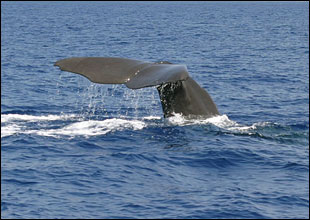 |
| The fluke of a huge diving Sperm Whale
in August 2005. Photo: HG Karlsson, Sweden. |
Madeira Whale Museum
The Madeira Whale Museum, Museu da Baleia, in the former whaling village
of Caniçal, was opened to the public on 28th May 1990, under the
direction of Sr. Eleutério Reis, an ex-whale hunter. The Museum
covers the history of the whaling period in Madeira as well as the cetaceans'
natural history and conservation. The history of whaling is displayed
using colour photographs and captions, from the hunt with hand harpoons
to the processing into oil and meal. Models of ships and so-called scrimshaw,
locally carved and engraved artefacts from the teeth and bones of whales,
are on display. It is like an excursion into the past of Madeira. From
1940 until 1981, when whaling finished in Madeira, 5,885 sperm whales
were killed. The prize showpiece of the Museum is a very lifelike, sectional
model of a 13m long, adolescent sperm whale bull hanging above the last
remaining whaling boat of the station. Today, the protection of marine
mammals is of prime importance in the territorial waters (EEZ) of the
archipelago. Therefore, since 1996 under the new direction of Dr. Luís
Freitas, the Museum integrated a team of marine biologists with the aim
of increasing the scientific knowledge of cetaceans inhabiting Madeiran
waters.
In 2004, the Museu da Baleia published the excellent book "Cetáceos
no Arquipélago da Madeira" (Freitas, L., Dinis, A., Alves,
F. & Nóbrega, F.). This very useful book contains an excellent
ID section, with both colour photographs and instructive colour plates.
Despite its original language being Portuguese, all depicted species are
shown with both English and scientific names. Unfortunately, this book
is not yet available to buy, however, Museu da Baleia plan to print an
edition for sale, in both the Portuguese and English language.
The museum is open every day (including weekends) except on Mondays, all
year round (except 25th December and 1st January). There is an entrance
fee of 1,25€ per person.
Here you'll find further
information about the conservation projects of cetaceans led by Museu
da Baleia>>
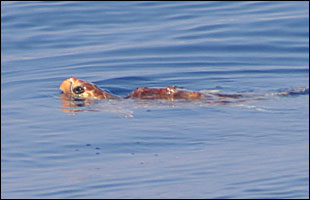 |
| A nice Loggerhead seen off Madeira in August
2005. Photo: HG Karlsson, Sweden. |
Sea Turtles
Sea Turtles are one of the most attractive, yet vulnerable, of all marine
vertebrates. They are widely exploited by man for their eggs, meat and
shell. Their survival is seriously threatened by many factors such as
pollution, loss of nesting sites, fishing and tourism. The eight species
of modern Sea Turtles are found within two families, the Dermnochelyidae
and the Cheloniidae. The former family is represented only by the
Leatherback. The other seven species of sea turtles are found in the family
Cheloniidae. All eight species are endangered.
Sea Turtles are large animals, the Leatherback attaining
a length up to 1,8m and a weight of over 500 kilos (for example one caught
off Wales in 1991 weighed 995 kilo!).
Five species have been recorded in Madeiran waters,
of which the Loggerhead is the commonest, while Green and Leatherback
are scarce but occur regularly.
| Loggerhead
Sea Turtle – Caretta caretta (Five photos from
Madeira – 2 NEW) Widely distributed in coastal and subtropical waters, but wanders into temperate waters. The largest species in the Cheloniidae family with a max weight up to 450 kg and length up to 1,5m, but today such large individuals are rare and the avarage weight lies just over 100 kg (rarely over 200 kg). Also nests in the Mediterranean Sea. |
| Green Sea Turtle – Chelonia mydas Widely distributed in tropical and subtropical waters, but rare in temperate waters. The size vary considerably through its range, normally about 1m across its carapace (1,39m as max) and in general the mass of a mature turtle ranges from 90 to 180 kg, but larger individuals (300-400 kg) occured quite regular in the past. Also nests in the Mediterranean Sea. |
| Hawksbill Sea Turtle – Eretmochelys imbricate Most tropical of the marine turtles and it is distributed throughout the central Atlantic and Pacific. Some hawksbills appear to be sedentary, rarely moving from one area, but others may undertake lengthy journeys across the oceans. Estimated world population of nesting females: about 8,000 only. |
| Kemp's Ridley Sea Turtle – Lepidochelys
kempii Usually only in the Gulf of Mexico. Occasionally seen off the coasts of Europe and NW Africa. Rarely exceeds 81 kg and 75 cm in length. Unlike other turtles, Kemp's Ridley laying its eggs during the day and in a much more rapid fashion than nocturnal egg-layers. Estimated world population of nesting females: about 2,000 only. |
| Leatherback Turtle – Dermochelys coriacea The species is undoubtly the most unusual of the marine turtles, not only in terms of its physical appearance, but also its distribution, as it ranges much further out of tropical waters in regular basis than other sea turtles. Several have been caught off the coast of Norway, and some have been found in waters inisde the Arctic Circle. The Leatherback is the largest marine turtle. Individuals weighing around 680 kg and measuring 1,8m in carapace length are known. Highly pelagic species. Also nests in the Mediterranean Sea. |
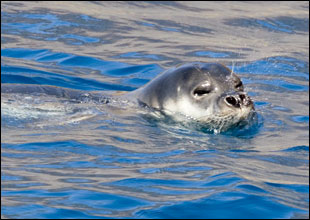 |
| A rare sight: A young Monk Seal off Desertas Islands in September 2006. Photo: Pat & Tony Halliday, UK. |
One spectacular sea mammal can be seen along the Madeiran coast, the Mediterranean Monk Seal (Monachus monachus). Once, these seals were so numerous the town of Câmara de Lobos (west of Funchal) was named after them: the name translates as "bed of wolves". In Madeira the species is commonly named "Lobo marinho" (which translates as "sea wolf") due to its barking and howling voice.
On Madeira, the Monk Seal originally used open beaches and easily-accessible caves to rest and to breed. However, this natural behaviour made the species vulnerable to human pressure. As a result, the population began to decline and eventually it disappeared from the island. In practice, the Desertas Islands became the last part of the Madeiran archipelago with suitable conditions for Monk Seal survival. In addition to the excellent food resources, the seals found security in these uninhabited and isolated islands. As a result of both direct and indirect harassment, the population at Desertas went into steep decline. In 1978, the estimated population size was 50 animals, but by 1988, only 6-8 individuals remained. A programme to protect this species was initiated in 1988 and, by 1990, the Desertas Islands were legally protected.
Today there exists a small colony of about 23 individuals that, due to the legal protection of these islands, has increased slowly but steadily over recent years. The permanent monitoring and protection of its habitat, assured by the Natural Park of Madeira, is vital for the preservation of this species.
 |
| This Monk Seal was seen off Desertas on 19th August 2005. Photo: Bosse Carlsson, Sweden. |
Brief facts about
the Monk Seal
(Main source: www.monachus.org)
At one time, the Mediterranean Monk Seal occupied a wide geographical
range. Colonies were found throughout the Mediterranean, the Marmara and
Black Seas. The species also frequented the Atlantic coast of Africa,
as far south as Mauritania, Senegal and the Gambia, as well as the Macaronesian
Islands. More recently, however, the species has disappeared from most
of its former range, with the most severe contraction and fragmentation
occurring during the last 50 years. Nations and island groups where the
monk seal has been extirpated during the 20th century include mainland
France and Corsica, Spain and the Balearic Islands, Italy, Sicily and
the Toscana archipelago, and Egypt, Israel, Lebanon and Tunisia. The species
is also thought to be on the brink of extinction in the Marmara and Black
Seas and the Adriatic coasts and islands of Croatia. As a result of this
range contraction, the Monk Seal has been virtually reduced to two populations,
one in the eastern Mediterranean and the other in the Northeast Atlantic,
off the coast of Northwest Africa (including Madeira).
The Mediterranean Monk Seal is listed as critically endangered by the
International Union for the Conservation of Nature and Natural Resources
(IUCN). This species is also listed on Appendix I of the Convention on
International Trade in Endangered Species (CITES). Extremely sensitive
to human disturbance, today the total world population of the Mediterranean
Monk Seal numbers between 300-500 animals.
The Mediterranean Monk Seal male reaches a length of about three metres
(average length 2.4m) and weighs approximately 300 to 400 kg. Females
are slightly smaller, weighing approximately 300 kilos. Adults are generally
brown or grey on the back, and lighter on the belly.
Web resources
Whale and Dolphin Conservation
Society (WDCS) is the leading international charity dedicated solely
to the worldwide conservation and welfare of all whales, dolphins and
porpoises (cetaceans).
Whales and Dolphins
(Organisation Cetacea) – Identification, photo gallery and much more
of the beloved cetaceans you'll find on this web site.
Marine
Wildlife at NOC (National Oceanography Centre, Southampton) –
Images and records of wildlife sightings during NOC cruises.
Acknowledgements
The text about Cetaceans (in top) is written by Catarina Alves and Luis
Dias, while Filipe Alves is the authour of the Madeira Whale Museum section
and its subpage (Protection of marine mammals). Also my great thanks to
Russel Wynn (Marine Wildlife at NOC) who have proof read and edited the
text on this page.
Copyright © 2004-2013, All rights reserved
Contact: Birding Madeira
 |